|
|
|
Sort Order |
|
|
|
Items / Page
|
|
|
|
|
|
|
| Srl | Item |
| 1 |
ID:
086999


|
|
|
|
|
| Publication |
2009.
|
| Summary/Abstract |
In February 1998, Osama Bin Laden published a signed statement calling for a fatwa against the United States for its having 'declared war against God'. As we now know, the fatwa resulted in the unprecedented attack of 9/11. The issue of whether or not 9/11 was in any way predictable culminated in the public debate between Richard Clarke, former CIA Director George Tenet and the White House. This paper examines whether there was any evidence of a structural change in the terrorism data at or after February 1998 but prior to June 2001, controlling for the possibility of other breaks in earlier periods. In doing so, we use the standard Bai-Perron procedure and our sequential importance sampling (SIS) Markov Chain Monte Carlo (MCMC) method for identifying an unknown number of breaks at unknown dates. We conclude that sophisticated statistical time-series analysis would not have predicted 9/11.
|
|
|
|
|
|
|
|
|
|
|
|
|
|
|
|
| 2 |
ID:
065632
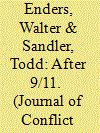

|
|
|
| 3 |
ID:
078494
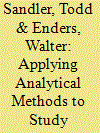

|
|
|
|
|
| Publication |
2007.
|
| Summary/Abstract |
This paper presents a perspective on the application of theoretical and empirical methods to the study of domestic and transnational terrorism. The use of such methods can lead to informed policy making. On the theoretical side, both choice-theoretic and game-theoretic methods are examined. For empirical applications, the paper focuses on the study of trend, cycles, and forecasting. Additionally, the use of intervention analysis in various forms is reviewed with to regards to evaluating policy effectiveness and quantifying the economic impact of terrorism. Although this paper is not intended as a literature review, some key studies are highlighted for readers to pursue in greater depth
|
|
|
|
|
|
|
|
|
|
|
|
|
|
|
|
| 4 |
ID:
143343


|
|
|
|
|
| Summary/Abstract |
This article reinvestigates the relationship between real per capita gross domestic product (GDP) and terrorism. We devise a terrorism Lorenz curve to show that domestic and transnational terrorist attacks are each more concentrated in middle-income countries, thereby suggesting a nonlinear income–terrorism relationship. Moreover, this point of concentration shifted to lower income countries after the rising influence of the religious fundamentalist and nationalist/separatist terrorists in the early 1990s. For transnational terrorist attacks, this shift characterized not only the attack venue but also the perpetrators’ nationality. The article then uses nonlinear smooth transition regressions to establish the relationship between real per capita GDP and terrorism for eight alternative terrorism samples, accounting for venue, perpetrators’ nationality, terrorism type, and the period. Our nonlinear estimates are shown to be favored over estimates using linear or quadratic income determinants of terrorism. These nonlinear estimates are robust to additional controls.
|
|
|
|
|
|
|
|
|
|
|
|
|
|
|
|
| 5 |
ID:
074827
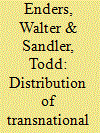

|
|
|
|
|
| Publication |
2006.
|
| Summary/Abstract |
This article applies an autoregressive intervention model for the 1968-2003 period to identify either income based or geographical transference of transnational terrorist events in reaction to the rise of fundamentalist terrorism, the end to the Cold War, and 9/11. Our time-series study investigates the changing pattern of transnational terrorism for all incidents and only those involving U.S. people and property. Contrary to expectation, there is no evidence of an income-based post-9/11 transfer of attacks to low-income countries except for attacks with U.S. casualties, but there is a significant transference to the Middle East and Asia where U.S. interests are, at times, attacked. We also find that the rise of fundamentalist terrorism has most impacted those regions-the Middle East and Asia-with the largest Islamic population. The end to the Cold War brought a "terrorism peace dividend" that varies by income and geography among countries. Based on the empirical findings, we draw policy recommendations regarding defensive counterterrorism measures.
|
|
|
|
|
|
|
|
|
|
|
|
|
|
|
|
| 6 |
ID:
106024
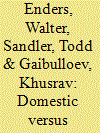

|
|
|
|
|
| Publication |
2011.
|
| Summary/Abstract |
This article devises a method to separate the Global Terrorism Database (GTD) into transnational and domestic terrorist incidents. This decomposition is essential for the understanding of some terrorism phenomena when the two types of terrorism are hypothesized to have different impacts. For example, transnational terrorism may have a greater adverse effect than domestic terrorism on economic growth. Moreover, the causes of the two types of terrorism may differ. Once the data are separated, we apply a calibration method to address some issues with GTD data - namely, the missing data for 1993 and different coding procedures used before 1998. In particular, we calibrate the GTD transnational terrorist incidents to ITERATE transnational terrorist incidents to address GTD's undercounting of incidents in much of the 1970s and its overcounting of incidents in much of the 1990s. Given our assumption that analogous errors characterize domestic terrorist events in GTD, we apply the same calibrations to adjust GTD domestic incidents. The second part of the article investigates the dynamic aspects of GTD domestic and transnational terrorist incidents, based on the calibrated data. Contemporaneous and lagged cross-correlations for the two types of terrorist incidents are computed for component time series involving casualties, deaths, assassinations, bombings, and armed attacks. We find a large cross-correlation between domestic and transnational terrorist incidents that persists over a number of periods. A key finding is that shocks to domestic terrorism result in persistent effects on transnational terrorism; however, the reverse is not true. This finding suggests that domestic terrorism can spill over to transnational terrorism, so that prime-target countries cannot ignore domestic terrorism abroad and may need to assist in curbing this homegrown terrorism.
|
|
|
|
|
|
|
|
|
|
|
|
|
|
|
|
| 7 |
ID:
092937


|
|
|
|
|
| Publication |
2009.
|
| Summary/Abstract |
Transnational terrorism data are difficult to forecast because they contain an unknown number of structural breaks of unknown functional form. The rise of religious fundamentalism, the demise of the Soviet Union, and the rise of al Qaeda have changed the nature of transnational terrorism. 'Old School' forecasting methods simply smooth or difference the data. 'New School' methods use estimated break dates to control for regime shifts when forecasting. We compare the various forecasting methods using a Monte Carlo study with data containing different types of breaks. The study's results are used to forecast various types of transnational terrorist incidents.
|
|
|
|
|
|
|
|
|
|
|
|
|
|
|
|
| 8 |
ID:
094734


|
|
|
|
|
| Publication |
2010.
|
| Summary/Abstract |
The authors analyze the optimal network structure of two types of terrorist organizations. In the centralized network, the leadership selects the level of individual effort and the level of group connectivity so as to maximize the expected net welfare of the organization's membership. Leaders in loosely connected networks will also seek to balance the trade-off between security and communications. However, with decentralized decision making, the individual nodes may not make optimal decisions from the group's perspective. As a consequence, the decentralized decision-making process is suboptimal from the overall perspective of the network. In particular, the leadership in a centralized network is able to coordinate the activities of all network members and to take advantage of important network externalities.
|
|
|
|
|
|
|
|
|
|
|
|
|
|
|
|
| 9 |
ID:
106022
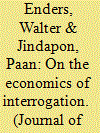

|
|
|
|
|
| Publication |
2011.
|
| Summary/Abstract |
While military protocol requires that POWs provide only name, rank, serial number, and date of birth (the so-called Big 4), it is naive to think that all detainees, including terrorists, behave in this fashion. Instead, there is evidence that detainees partially cooperate with their captors by revealing a limited amount of valuable information during the interrogation process. Such a strategy makes it appear that the detainee is cooperative and, since interrogations can be costly, serves as a disincentive for further interrogation. In order to capture the essential differences between the two strategies, we model two different types of games between the interrogator and the detainee. Specifically, we compare the Big 4 game to a two-stage game (the Little Fish game) in which the detainee is permitted to reveal low-level information to the interrogator. We formalize both games, derive the optimal rules for each player, and show that the Big 4 game may not be optimal for either player or for the overall well-being of the interrogating nation. As such, the Little Fish game can Pareto-dominate the Big 4 game. Hence, it is possible that the al-Qaeda strategy of partial cooperation is superior to that used by most standing armies. We also show that the level of intensity selected by the interrogator must be balanced by such factors as the moral values of the society and recruiting potential of the terrorists versus the likelihood of obtaining important information.
|
|
|
|
|
|
|
|
|
|
|
|
|
|
|
|
| 10 |
ID:
071944


|
|
|
|
|
| Publication |
Cambridge, Cambridge University Press, 2006.
|
| Description |
xiii, 278p.
|
| Standard Number |
0521616506
|
|
|
|
|
|
|
|
|
|
|
|
Copies: C:1/I:0,R:0,Q:0
Circulation
| Accession# | Call# | Current Location | Status | Policy | Location |
| 051305 | 303.625/051305 | Main | On Shelf | General | |
|
|
|
|
| 11 |
ID:
077067


|
|
|
|
|
| Publication |
2007.
|
| Summary/Abstract |
After the events of 9/11, U.S. counterterrorism became more proactive in that the Patriot Act allowed the authorities far more freedom to directly attack terrorist network structures. We argue that rational terrorists will attempt to thwart such policies and restructure themselves to be less penetrable. We model the trade-off between security and intragroup communication faced by terrorists. The model is used to derive the anticipated changes in network structure and the consequent changes in the type, complexity, and success rate of potential terrorist attacks.
|
|
|
|
|
|
|
|
|
|
|
|
|
|
|
|
| 12 |
ID:
136957


|
|
|
|
|
| Summary/Abstract |
It is generally deemed that domestic and transnational terrorism respond to different types of events. This study updates Enders, Sandler, and Gaibulloev’s previous analysis to include data through the fourth quarter of 2010 and provides analysis of terrorism at the regional level. Vector autoregressions are used to show that previous findings are accurate on the whole, but that there are important differences between regions. Notably, the Granger-causality for the world depends on whether Iraq and Afghanistan are included in the sample, and impulse response functions highlight the persistent effect a shock to transnational terrorism can have on domestic terrorism.
|
|
|
|
|
|
|
|
|
|
|
|
|
|
|
|
|
|
|
|
|